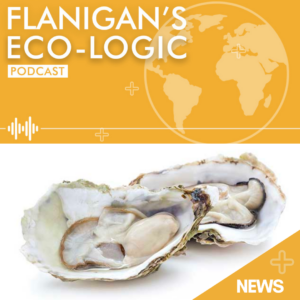In This Issue
- Flanigan’s Eco-Logic: Oyster Bay, Long Island
- Nutritional and Ecological Values of Oysters
- Tesla Considering Heat Pumps
- High Speed Rail to Las Vegas
- Six Ways to Remove CO2 from the Atmosphere
- Flanigan’s Ego-Logic Podcast Updates
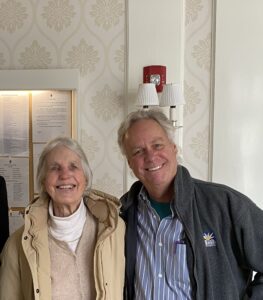
Flanigan’s Eco-Logic: Oyster Bay, Long Island
The small waterfront Village of Oyster Bay where I grew up, and where my mother lives, is known for at least three things: First, the oysters! Oyster Bay has a history of producing ~85% of New York State’s oyster harvest. Second, Oyster Bay was the Summer White House for, and is the final resting place of, U.S. President Theodore Roosevelt. Third: Billy Joel!
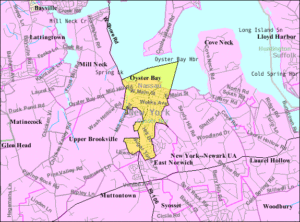
“Oyster” is the common name for a number of different families of salt-water bivalve molluscs. They live in brackish and saltwater bays like Oyster Bay, as well as estuaries, tidal creeks, shallow ocean areas, and intertidal zones. Most oysters, but not all, are in the family Ostreoidea. There are different oyster species: Atlantic, European Flat Oysters, Pacific Oysters including Blue Point, Shigoku, and Kumiai Oysters.
You know… people seem to love ‘em or hate ‘em, or are too nervous to try them! Yes, oysters certainly create an unusual sensation going down the hatch. Just the other night, my EcoMotion colleague Mark Hopkinson and I each had a dozen local oysters, each of us artfully dabbing them with fine blends of horseradish, cocktail sauce, and a vinegar concoction. Mom had the clams.
The next day, we head to the Oyster Bay waterfront, to the site of the old Jacobson’s Shipyard which serviced New York City tugboats when I was a kid. The big M on their side is etched in my memory and refers to Moran Marine Transportation and Harbor Services.
We were at the Waterfront Center to check out the restoration of the 50-foot oyster boat, the Ida May. It’s a community project led by our friend George Lindsay and the Christeen Oyster Sloop Preservation Corporation. Its mission is to preserve Oyster Bay’s marine heritage by involving the community in traditional boat building.
The Ida May is an historic oyster boat that plied the harbor here for 75 years, until 2003. It was one of the first oyster dredges to be powered by an engine. Prior to that, oyster men used sailing sloops to harvest oysters. Turns out the original Ida May, built in 1925, was too rotten to recondition.
Christeen, made up of a group of community leaders, have raised a million dollars for the construction of an exact replica of the Ida May. This includes a Billy Joel donation. Six professional shipwrights work every day on the Ida May, guiding teams of volunteers.
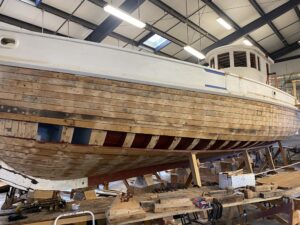
When launched this spring, the Ida May will be a floating classroom, a Coast Guard certified vessel able to take out 49 students at a time to dredge and harvest and to raise awareness about the role of oysters in local marine ecology and Oyster Bay’s maritime history. The Ida May is planned to launch on May 3.
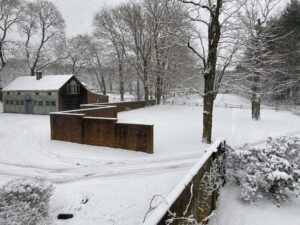
It’s a good walk from our property to the cove, a small beach access where I launched my Laser for summer day sailing. This past month, the cold temperatures of February accented with snow flurries – had me walking briskly indeed, tracking my steps on my Oura. I am drawn to the water. Cold water, cold birds, boats out.

Theodore and Edith Roosevelts’ grave is just across from the cove, up on a hill overlooking his beloved Oyster Bay. I walked up to their grave site, to this day managed by my classmate Phil Roosevelt. I am once again struck by its simplicity. I am alone. There’s a fresh blanket of wet snow. The grave is humbly fenced and marked. I think of the man I’ve read so much about. I marvel at the serenity of these hallowed woods, a wonderful resting place.
One day I walk the extra miles to Sagamore Hill, Theodore Roosevelt’s home. I trek briskly along the winter water’s edge. Then up to Sagamore Hill which sits proudly on a hill; a spectacular promontory. The setting is complete with barns and a wind-powered water pumper. It’s a gray, overcast, New York day. Today the home and acreage is a National Historic Site managed by the National Park Service. I chat with a friendly ranger and use a posted qwerty code to get the more details.
The house was originally called “Leeholm,” named after TR’s first wife, and then later named Sagamore Hill. “Sagamore” is the Algonquin word for “chieftain, the head of the tribe.” The house was built in 1884 and then expanded in 1905. The addition includes the famous North Room, full of hunting trophies and gifts from foreign dignitaries.
The 26th president lived at Sagamore Hill for 30 years until his death in 1919. After his two-term presidency, and before embarking on his trip down the River of Doubt, Sagamore Hill is where TR went to lick his wounds after his humiliating presidential defeat to William Howard Taft in 1909. At Sagamore Hill, TR had his game room, wonderful forests and great views of the harbor… a path down to the beach.
Billy Joel is proud of his Oyster Bay roots… “From a town known as Wheeling, West Virginia…. From a town known as Oyster Bay, Long Island…” And the town is proud to have him live here. He now calls Oyster Bay home. And why not? He’s got his roots there and he can always fly a helicopter from his home on Centre Island in Oyster Bay to the roof of Madison Square Garden in New York City. That’s a venue he has sold out more than 70 times. He calls the Garden his “office.” Sound checks are done earlier by his longtime piano roadie. Billy Joel flies in, walks on stage, performs to wildly enthusiastic fans and great applause, and then helicopters home.
Billy Joel was born in the Bronx. He then moved out on Long Island and went to Hicksville High School. At his mother’s insistence, he took piano lessons. His teacher also taught ballet, and Joel would be ridiculed going to and from his lessons. Later he became a boxer to defend himself. He became a Golden Gloves amateur who won 22 bouts. Apparently he abandoned that after a broken nose in bout #24.
Billy Joel dropped out of high school and then made clear his direction to pursue music. “To hell with it. If I’m not going to Columbia University, I’m going to Columbia Records, and you don’t need a high school diploma over there.” He went on to become one of the best selling music artists of all time. He is the seventh best-selling recording artist and fourth best-selling solo artist in the United States with over 160 million records sold worldwide. And yes, he did get his high school diploma 25 years later.
He had huge hits in the 1970s and 1980s. Piano Man became his signature song. He went from being a solo artist to working with full rock bands. In 1987 he was one of the first artists to perform a concert tour in the Soviet Union following the country’s alleviation of the ban on rock music. He self-penned 33 Top 40 hits in the U.S., won six Grammy awards, and was inducted into the Rock and Roll Hall of Fame.







